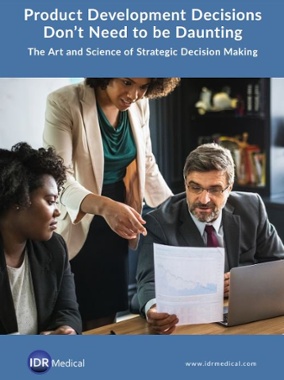Switzerland (Head Quarters)
IDR Medical Switzerland
Austrasse 95, CH-4051 Basel, Switzerland
T:
+41 (0) 61 535 1109
UK
IDR Medical UK
Unit 104 Eagle Tower, Eagle Tower
Montpellier Drive, Cheltenham, GL50 1TA
T:
+44 (0) 1242 696 790
USA
IDR Medical North America
225 Franklin Street, 26th Floor
Boston, Massachusetts 02110, USA
T:
+1 (0) 617.275.4465

What is Decision Analysis, and how can it benefit my team?
Ever been baffled, or even paralysed, by the overwhelming complexity of a strategic decision that you or the team have been tasked with making? The medical device regulatory environment alone creates a level of complexity that usually requires the services of a specialist, and this is certainly not the full extent of it.
The development of a new medical device is extremely complex and typically requires a cross-functional team to manage the project. Making decisions in such a highly interwoven multi-stakeholder environment only adds to the challenge… and complexity. On top of this, the external environment is also in a constant state of flux. Not only is the profile, functionality, and specification of your device still being finalised, the future of the market in which it will compete is most likely also not known with any degree of certainty.
How does one make a robust decision in the face of such complexity and uncertainty?
Have you ever come across the term Decision Analysis? It is an approach to decision making first devised at Stanford University to support robust decision making in such a setting of complexity and uncertainty. It consists of a framework of clearly defined processes and a set of validated tools.

It is more of a single continuous and iterative process than a stepwise approach, but for illustrative purposes, it can be broken down into 5 steps. It isn’t a prescriptive approach, and single elements can be pulled out if they will be particularly helpful/relevant to the decision that needs to be made.
- Discovery. During the discovery phase, the team assesses the decision environment to confirm what is known. And not known. What are the background issues and opportunities? For any unknowns that are decision critical, work can be commissioned to provide more illumination.
- Framing. Restate the decision that needs to be made, why it is important to the organisation and define the scope. So often individuals go into this process with different views on the task in hand.
- Alternatives. This is largely a creative exercise. What are the possible viable solutions? The team should expect to identify some previously unconsidered options.
- Evaluation. A qualitative and quantitative exercise. Should only be as detailed as is necessary to reveal the best option.
- Decision. What is the best path forward? And, more importantly, a very clearly documented rationale why this is the most attractive option. This is often a hybrid of some of the options described in point 3.

This approach can embolden decision makers. Rather than ignoring or papering over the inherent market and product uncertainties, these are embraced and quantified by the individuals most qualified to assess them. A good decision does not guarantee a good outcome. The decision analysis approach deliberately and quantitatively assesses the risks and uncertainties and ensures they are appropriately factored into the decision. Whatever the outcome, a good decision maker will be able to look back at the process and be confident that, considering what was known (and not known) at the time, the decision was a good one. Of course, one could also argue that if the outcome is so uncertain, then it would be better not to make a decision, but that will almost always incur its own cost.
Within the IDR Medical team we have experienced Decision Analysis practitioners and if you have a major decision of a medical device looming, we would be happy to offer a free consultation on how this approach could be applied to support your product development process. For more information, download our free guide to strategic decision making here.


